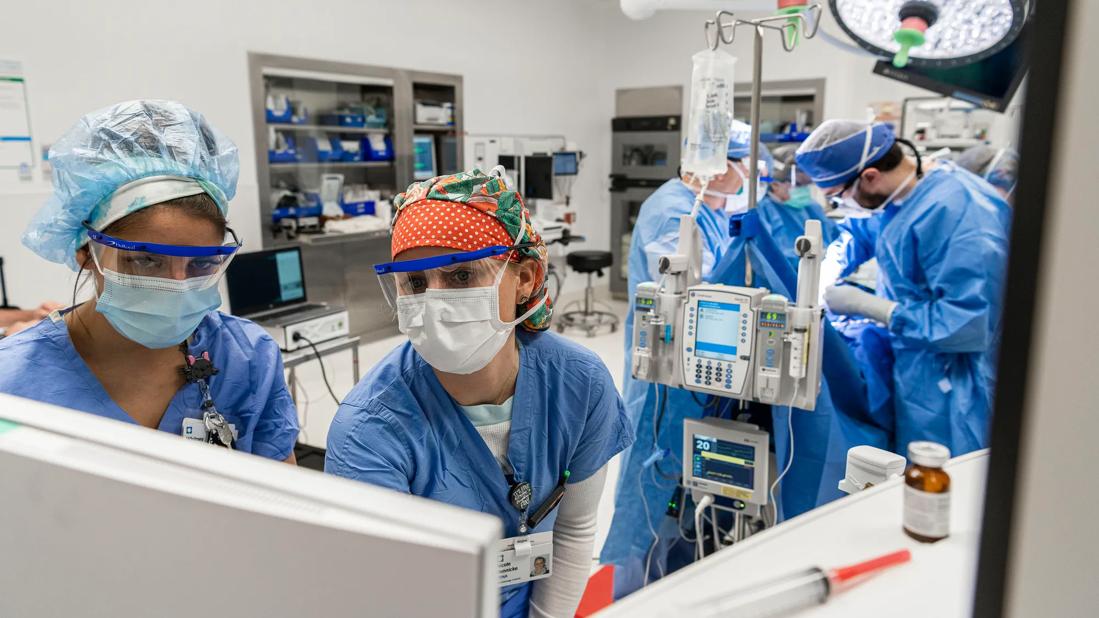Study looks at effect of OR setting on patient anxiety

When Cleveland Clinic Marymount Hospital built nine new operating rooms several years ago, one of the rooms was set up with a multimedia system for creating a calming environment for patients. The director of surgical services and several nurses saw an opportunity to study whether the high-tech multimedia system decreased anxiety for patients undergoing surgery compared to a standard OR.
Advertisement
Cleveland Clinic is a non-profit academic medical center. Advertising on our site helps support our mission. We do not endorse non-Cleveland Clinic products or services. Policy
“We believed that having a calming environment for patients to go to sleep and wake up in would promote a healing environment,” says Natalie Kalabon, RN, a clinical nurse in Surgical Services at Marymount Hospital who participated in the research project.
Marymount Hospital used two identical OR suites for the randomized controlled study, which was funded by STERIS – one with STERIS’ SignatureSuite system and one standard OR. Participants were adult patients undergoing thyroid or parathyroid surgery who were assigned to either the experimental or standard OR via a modified stratified cluster method by the surgeon’s room assignment for the day. Patients in the SignatureSuite OR could choose one of four nature videos to view on monitors while relaxation music played overhead.
The anxiety level of patients was measured using four 100-millimeter visual analog scales (VAS) ranging from “no anxiety” to “most anxiety I can imagine” on arrival, prior to anesthesia induction, on arrival to the Post Anesthesia Care Unit (PACU) and prior to discharge from the PACU. The Kindler Preoperative Anesthesia Anxiety Scale was used to evaluate surgery-specific anxiety. In addition, heart rate and systolic blood pressure were abstracted from the electronic medical record, along with demographic and medication data.
A total of 100 patients participated, divided evenly between the two operating rooms. “There was no statistically significant difference between the control group in the standard OR and the SignatureSuite group for anxiety, systolic blood pressure and heart rate,” says Brenda Odabashian, BSN, RN, CNOR, Assistant Nurse Manager of Surgical Services at Marymount Hospital. However, there were some interesting trends that merit further study, including the following:
Advertisement
Researchers acknowledge some limitations of the study. For instance, the study took place in one hospital with a single population of thyroid and parathyroid surgery patients having general anesthesia. A larger sample size and different patient populations undergoing surgery may lead to differences on measures of anxiety. Also, a replication study without use of anxiolytic medications administered preoperatively should be conducted to determine if that factor would alter outcomes.
“Even though data were not significantly different between groups, I was in the operating rooms with a lot of patients,” says Kalabon. “You could tell the difference between a room with nature scenes on the monitor and music playing. Patients’ attention was diverted to the monitors rather than the scrub technician setting up the table or the anesthesia machine.”
This anecdotal evidence has led the research team to design a follow-up qualitative study investigating perceptions of OR staff members (surgeons, nurses, scrub technicians, surgical assistants and anesthesia providers) on the effect of the SignatureSuite OR environment on the surgical team and patients.
Advertisement
Advertisement

Compassion, communication and critical thinking are key

Study illuminates value of shared decision-making

How hospitals can weave ethics into daily nursing practice to strengthen patient-centered care

Mobility carts provide exercises and tools

Nurse researchers explore the relationship between readmission risk scores and acute care transfers

Guiding nurses amid a constantly evolving healthcare landscape

Ideation session generates solutions to medication administration errors

Caregivers spearhead changes that improve patient care, shape hospital culture